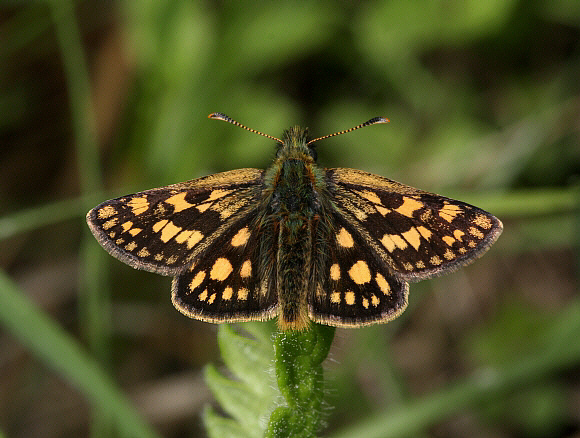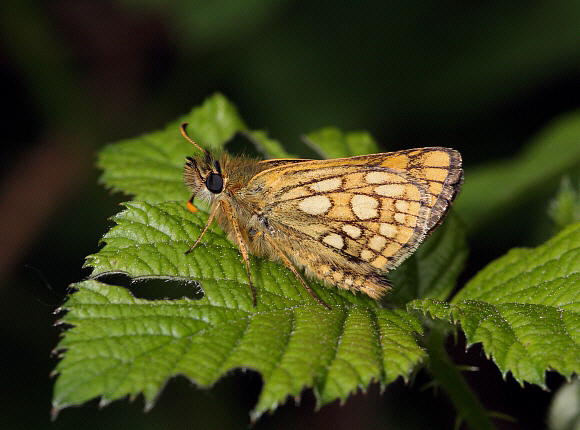 Carterocephalus palaemon, Szalafo-pityerszer, Orseg, Hungary – Peter Bruce-Jones
Carterocephalus palaemon, Szalafo-pityerszer, Orseg, Hungary – Peter Bruce-Jones
Introduction
There are 15 Carterocephalus species. The genus is centred on China, but 3 species reach Europe including palaemon.
Older literature treats Carterocephalus as a member of the Hesperiinae, but the genus is currently placed in the Heteropterinae due to differences in the structure of the antennae, palpi and venation. There are only a few members of the Heteropterinae which occur in the northern hemisphere. In South America there are many related species in the genus Dalla – largely montane species from the Andes; and another similar genus, Metisella, occurs in the tropics of Africa.
All Carterocephalus species are dark brown with yellow or cream markings. The pattern is repeated on the underside, but in muted colours.
In Britain palaemon is known as the Chequered Skipper, but in the USA and Canada it is usually referred to as the Arctic Skipper or Arctic Skipperling. The butterfly is found across most of central and northern Europe, although absent from Spain, Portugal, peninsular Italy and the Mediterranean coast. Beyond Europe it occurs across much of temperate Asia to Siberia, China and Japan. It is the only Carterocephalus species found in North America where it occurs in California, southern Alaska and across most of Canada.
 Carterocephalus palaemon, Kercaszomor, Hungary – Peter Bruce-Jones
Carterocephalus palaemon, Kercaszomor, Hungary – Peter Bruce-Jones
Habitats
In England the Chequered Skipper was once quite widespread, occurring across most of the central and eastern counties, but it contracted it’s range, partly as a consequence of drainage of the Great Fen, which led to the large scale conversion of land to agriculture. By the early 20th century the species was thought to be confined to a few counties in the east Midlands, and although it remained fairly common in certain areas until the early 1960’s, within a decade populations at all its English sites had collapsed, and by 1975-76 it had become extinct. Reintroduction trials have taken place since 1990 with varying degrees of success.
The butterfly’s presence in Scotland was not known until 1942 when it was discovered by a collector Mackworth-Praed in Western Inverness. The butterfly had in fact been known from another nearby locality for 3 years previously, having been found by Evans, but that site was a well kept secret.
In 1982 I surveyed the Highlands for this species, and found it widespread, discovering 14 colonies including 4 that were previously unknown. Since that time further studies have been carried out by Butterfly Conservation, and it is estimated that the butterfly currently ( 2009 ) breeds in about 10 core areas. Within that total area there are about 40 discrete colonies.
In Scotland the butterfly is found at warm, sheltered, damp sites where the larval foodplant, purple moor grass Molinea caerulea grows in lightly wooded areas, often in the vicinity of small streams. Examples include open oak woods, lightly wooded gullies on hillsides and mountains, sunny glades in birch woodland, young conifer plantations, damp scrubby areas on northern and eastern shores of Lochs, woodland clearings, and roadside verges in wooded areas. Most Scottish colonies occur at altitudes between sea level and about 200m. Colonies vary considerably in size, some comprising no more than a couple of dozen insects breeding in a woodland glade, while others may comprise of several hundred butterflies spread over a 5 mile stretch of lightly wooded valley bottom.
In mainland Europe the Chequered Skipper occurs at altitudes up to about 1600m and it is far less fussy about its habitats, although it occurs primarily in damp, sunny glades and woodland clearings.
Climate change is likely to cause local extinctions in more southern localities, but the butterfly may successfully colonise new areas further north e.g. in Scotland and Fennoscandia. Existing colonies in Scotland and the Alps will probably be forced to move to higher altitudes as the lowlands become too warm to support the butterfly and its habitat.
Lifecycle
In Scotland the butterflies emerge in late May and fly until mid June.
The shiny white spherical eggs are laid singly on the underside of grass blades. Oviposition occurs primarily on grasses growing in dappled sunlight beneath bog myrtle bushes. They are usually laid on Molinea caerulea, but occasionally on Brachypodium sylvaticum, which was the grass used by the species at it’s former English sites. A much wider range of grasses are used in Europe and North America.
The caterpillar makes it’s first meal of the eggshell. It later constructs a shelter made by rolling a blade of grass into a tube, held together with strands of silk. As it grows, it moves to other grass blades and constructs larger tubes. It feeds diurnally, eating little notches out of the grass blade above and below where it rests.
Like other grass-feeding skippers, the larva is equipped with a pair of prongs at the tail end, which it uses to flick away it’s droppings. This helps to prevent the grass shelter from becoming fouled, and also removes evidence of the larva’s whereabouts, which might otherwise attract parasitoids or predators.
In late September, when the larva is fully grown, it constructs a silken tent amongst the grass blades, where it hibernates until April. The mature larva is pale green, but during the autumn the colour gradually changes to pale straw, matching the surroundings.
Prior to pupation in early May, the larva constructs yet another shelter, made from dead grasses and silk. The long thin chrysalis is formed within the shelter. It is pale ochreous, marked with dark lines along the back and sides. The pupal stage lasts for about 2 weeks.
Adult behaviour
On sunny mornings males establish perches on bushes. They use these vantage points to survey passing females and defend the territories vigorously against all passing insects. Other males are promptly ousted from the vicinity. When a female is intercepted she is chased until she settles, and copulation then takes place immediately. The pair remain joined for about an hour, during which time they sit with wings held erect, on grass blades or other low foliage.
Both sexes spend long periods basking on the terminal leaves of shoots of bog myrtle, birch, and other small trees or shrubs. Unlike Hesperiine skippers, but like the Pyrginae, they usually bask with their wings spread flat, usually with the forewings draped slightly backwards.
They nectar, with wings closed, at dandelion and bugle, but also visit marsh lousewort, bluebells, and orchids. In Scotland, and in the French Alps, I have often found them mud-puddling, always singly, at ditches or wet soil.
In dull dry weather and overnight, the butterflies roost on the terminal leaves of small bog myrtle bushes, or sometimes on bracken fronds or clumps of heather. In wet weather they hide themselves deep within grass tussocks.
